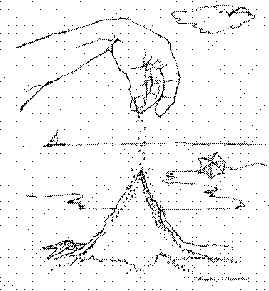
Self-organised criticality is a new way of viewing nature. The idea of self-organised criticality (SOC) is commonly illustrated conceptually with avalanches in a pile of grains. The grains are dropped onto a pile one by one, and the pile ultimately reaches a stationary `critical' state in which its slope fluctuates about a constant angle of repose, with each new grain being capable of inducing an avalanche on any of the relevant size scales.

Tale of the sandpile: Take a square table and a large bucket of sand. We begin sprinkling grains of sand on the table, one grain at a time. We drop the grain on a randomly chosen place on the table and repeat the act after all motion has terminated. In the beginning the grains just fall on the table in no particular pattern. The system is close to the state with minimal energy, the flat sandpile. The system is linear. Small perturbations can cause only small responses.
But subsequently, while continuing to add new grains of sand, we notice the formation of small local avalanches. The mechanism of the local avalanches is to decrease the local slopes whenever they become to steep. Perturbing the system, the small sandpiles, provoked by avalanches, create still greater sandpiles and eventually we end up with only one big sandpile, see Fig. 2.

At some point (the transient time) this pile ceases to grow. The (global) average slope has reached a steady state corresponding to the angle of repose which the sandpile cannot exceed no matter how much sand we add. The pile has reached a statistically stationary state and additional grains of sand will ultimately fall off the pile. This state is far far away from the state which minimises the energy, the flat sandpile. The avalanches are clearly necessary in order to relax the sandpile but we notice an unpredictability concerning the size of the avalanches. An avalanche is triggered the moment we add a grain of sand that causes the local slope to exceed the critical value. The variation of the local slopes makes it impossible to predict what will happen when we add a new grain of sand: Either it triggers a global avalanche or the perturbation simply results in small local rearrangements. Occasionally, the additional grain of sand just stays where it fell and no avalanche is produced. The system has, in some sense, infinite susceptibility. It reacts in a highly nonlinear way to small perturbations.
The metaphor of the sandpile describes a system with many units that interact locally. It reaches a dynamical attractor which is far from the equilibrium state. There is no way we can study one grain of sand and infer the behaviour of the resulting sandpile. (``Ideas thus made up of several simple ones put together, I call complex; such as beauty, gratitude, a man, an army, the universe.'' -- John Locke.) A new behaviour emerges as a result of interactions between the many simple units. This is the very heart of complexity.
We have demonstrated, that self-organized criticality might occur in a slowly driven granular pile of rice as long as friction dominates inertia effects.
The applications of SOC go well beyond granular piles but the basic picture remains the same: many slowly driven nonequilibrium systems organize in a poised state -- the critical state -- where anything can happen within well-defined statistical laws.
The seismic system is probably the most direct example of a self-organised critical phenomenon in nature. The relative movement of tectonic plates causes strain to build up along the plate boundary. When the static friction cannot sustain the stain any more, it is released through earthquakes, the statistics of which is described by the Gutenberg-Richter law.
The avalanches of various sizes can be literal, as in the granular pile or the seismic system, or they can be metaphorical like mass extinctions in biology or stock market crashes in economics. In all cases, the large events are intrinsic to the dynamics and need no special explanation. The same forces that created a small earthquake in San Francisco yesterday also caused the 1907 earthquake and similar, the forces which made the Dow Jones average drop five points yesterday also caused the crash of 1987.
At present, we study models of granular media (sand piles). The main object is to address the question of coorelations, predictability and whether simples models of SOC are related to the ubiquitous occurrence of fractal temporal structures such as 1/f (one-over-f) noise. Also, at the interface between SOC and biology, we study models of evolution with a special interest in the causes and modes of speciation.
References